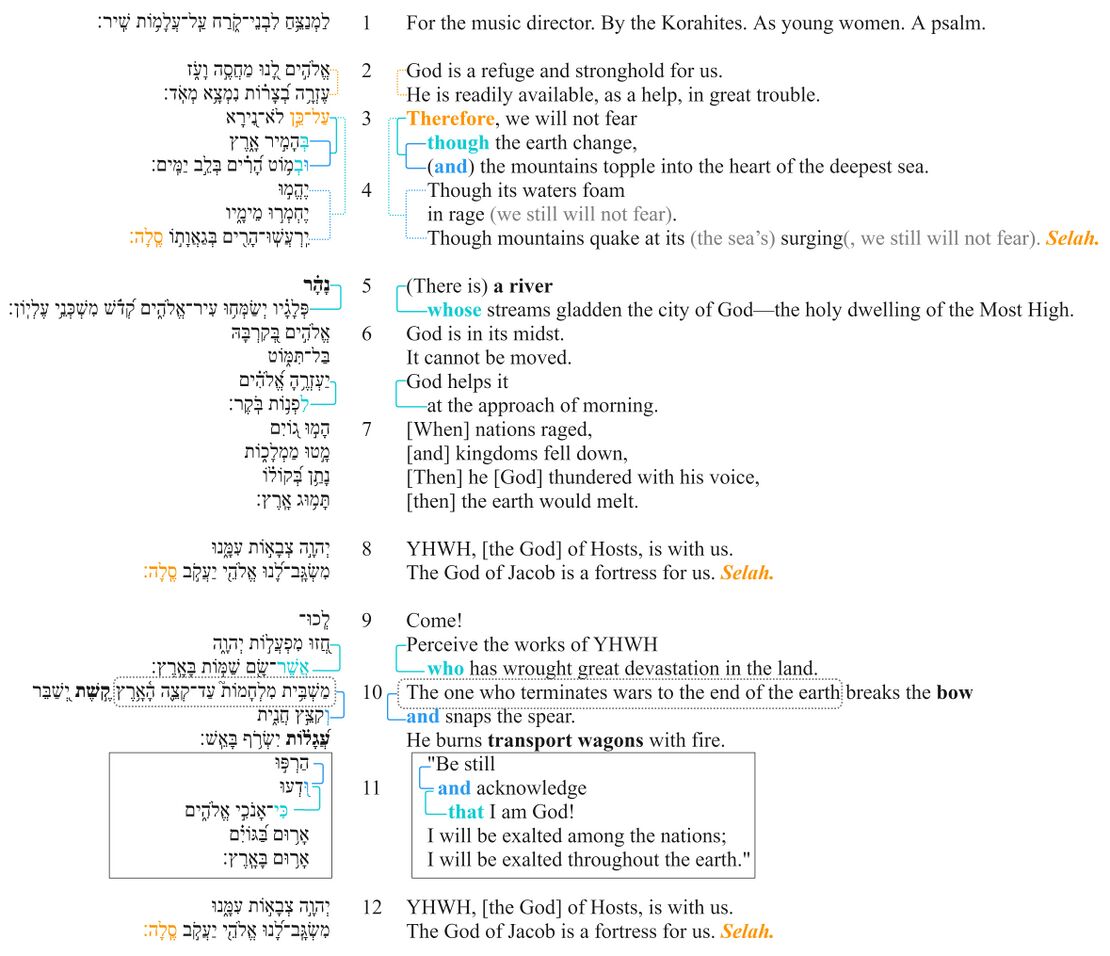Psalm 46 Macrosyntax
From Psalms: Layer by Layer
Psalm 46/Macrosyntax
Choose a PsalmNavigate Psalm 46
Macrosyntax
Macrosyntax Diagram
| Macrosyntax legend | |
|---|---|
| Vocatives | Vocatives are indicated by purple text. |
| Discourse marker | Discourse markers (such as כִּי, הִנֵּה, לָכֵן) are indicated by orange text. |
| The scope governed by the discourse marker is indicated by a dashed orange bracket connecting the discourse marker to its scope. | |
| The preceding discourse grounding the discourse marker is indicated by a solid orange bracket encompassing the relevant clauses. | |
| Subordinating conjunction | The subordinating conjunction is indicated by teal text. |
| Subordination is indicated by a solid teal bracket connecting the subordinating conjunction with the clause to which it is subordinate. | |
| Coordinating conjunction | The coordinating conjunction is indicated by blue text. |
| Coordination is indicated by a solid blue line connecting the coordinating clauses. | |
| Coordination without an explicit conjunction is indicated by a dashed blue line connecting the coordinated clauses. | |
| Marked topic is indicated by a black dashed rounded rectangle around the marked words. | |
| The scope of the activated topic is indicated by a black dashed bracket encompassing the relevant clauses. | |
| Marked focus or thetic sentence | Marked focus (if one constituent) or thetic sentences[1] are indicated by bold text. |
| Frame setters[2] are indicated by a solid gray rounded rectangle around the marked words. | |
| [blank line] | Discourse discontinuity is indicated by a blank line. |
| [indentation] | Syntactic subordination is indicated by indentation. |
| Direct speech is indicated by a solid black rectangle surrounding all relevant clauses. | |
| (text to elucidate the meaning of the macrosyntactic structures) | Within the CBC, any text elucidating the meaning of macrosyntax is indicated in gray text inside parentheses. |
If an emendation or revocalization is preferred, that emendation or revocalization will be marked in the Hebrew text of all the visuals.
| Emendations/Revocalizations legend | |
|---|---|
| *Emended text* | Emended text, text in which the consonants differ from the consonants of the Masoretic text, is indicated by blue asterisks on either side of the emendation. |
| *Revocalized text* | Revocalized text, text in which only the vowels differ from the vowels of the Masoretic text, is indicated by purple asterisks on either side of the revocalization. |
(Click diagram to enlarge)
- The first section break comes after v. 4. This is indicated by a.) the presence of a Selah, a discourse marker, and b.) the opening clause of v. 5, which is a thetic statement, activating new referents ("the river and its streams").[3]
- The second section break comes after v. 7, which is indicated by the appearance of the refrain (v. 8). After it, comes a section demarcated by 2 sets of imperatives, the second of which is direct speech.
- The last section is marked by the refrain (v. 12), which in turn is marked by the final, third Selah.
- The two clauses (v. 2a and 2b) are parallel, exhibiting an inversion of clause components, i.e., עֶזְרָ֥ה בְ֝צָר֗וֹת is fronted in v. 2b. The parallel elements are אֱלֹהִ֣ים לָ֭נוּ/"God for us"//נִמְצָ֥א מְאֹֽד/"readily available" and מַחֲסֶ֣ה וָעֹ֑ז/"a refuge and stronghold"//עֶזְרָ֥ה בְ֝צָר֗וֹת/"a help in great trouble" (> a.b|b’.a’).[4] Through such arrangement of constituents the text creates a chiastic pattern (BHRG §47.2.1[6]) whereby אֱלֹהִ֣ים לָ֭נוּ and נִמְצָ֥א מְאֹֽד stand at the beginning and end of their respective cola and frame the roles God plays in the lives of his people: מַחֲסֶ֣ה וָעֹ֑ז, עֶזְרָ֥ה בְ֝צָר֗וֹת. This inversion of syntactic constituents is poetically motivated, i.e., it centers the benefits of God's presence in his people's lives. The symmetry of v. 2 echoes the symmetry of the refrain in vv. 8 and 12 (a.b|b’.a’).[5]
- "[There is] a river" is a thetic statement, containing new information and a new referent, but the fact that it contains a body of water echoes the waters from vv. 3-4. Hence, v. 5a indicates the beginning of a new section/strophe (vv. 5–7), which focuses on God's holy city in the context of tumult in the political realm. Subject fronting in v. 5b (פְּלָגָ֗יו יְשַׂמְּח֥וּ) could be due to syntactic consideration, i.e., to assist in understanding the rest of the statement ([from Ian] see, e.g., Deut 8:9; 29:17; Ps 26:10; 144:7-8, 11; Prov 2:14-15; Eccl 10:16-17).
- The refrain (v. 8, 12) has a symmetric word order (a.b|b’.a’).[6] In it, in v. 8b (12b), מִשְׂגָּֽב־לָ֝נוּ is fronted to create a chiasmus with v. 8a (12a). This non-default word order in v. 8b (v. 12b) echoes v. 2b, i.e., its fronting of עֶזְרָ֥ה בְ֝צָר֗וֹת, and the resultant chiasmus of v. 2. In vv. 8-12, the refrain has a structuring function, i.e., it demarcates vv. 9-11 through an inclusio.[7] The word Selah appears at the end of each refrain.
- In v. 10, the text first makes a general statement about God's military activity, i.e., him terminating all wars (v. 10a, cf. v. 9), which is topical. Following this, the text zooms in on more specific acts, i.e., the destruction of implements of war (v. 10bcd), which are topically accessible (cf. vv. 9, 10a). By fronting objects in v. 10b, d, the text focalizes offensive weapons (i.e., the bow) and carts carrying supplies. This in turn indicates topic specification or expansion (BHRG §47.2.1). The reason for the unmarked word-order in וְקִצֵּ֣ץ חֲנִ֑ית is that of defamiliarisation[8], i.e. a symmetrical pattern embedded between v. 10b and 10d. "The particular ordering of the B-line in this case, we suggest, is not due to matters of pragmatics, but rather is simply a variation from the order of A, which in this context is allowable in that the marked order of A is restored in C, following the temporary departure from it in B. So taking all things into consideration, it is more accurate in such contexts as these to label the medial clause as DEF rather than CAN, since its form is a manifestation of poetic defamiliarisation (i.e. departure from the norm) rather than a question of pragmatic non-markedness. Psalm 46:10 we therefore interpret as MKD//DEF//MKD."[9]
There are no notes on vocatives for this psalm.
- In v. 3, there is an עַל־כֵּ֣ן, which is an adverb, which serves as a discourse marker. Based on its components (i.e., "over" or "because of" + "these x"), this lexeme "has the deictic value of 'because of these'" (BHRG §40:38). In HB, it usually governs either qatal/perfect or yiqtol/imperfect clauses, which follow a cluster of other statements. In them, "reference is made to the grounds of the factual outcome (or result) that עַל־כֵּ֣ן introduces" (BHRG §40:38). So, in Ps 46:3, based on the assertions of v. 2 which indicate God's protection of and availability to his people, עַל־כֵּ֣ן points to "the factual outcome", i.e., the community "will not fear". The two subordinate, and coordinated statements (i.e., 'when the earth changes, (and) when the mountains topple into the heart of the deepest sea') indicate scenarios in which God's people will not fear. Macrosyntactically, there is nothing to suggest a discontinuity between vv. 2 and 3 (e.g., Selahs appear later in the psalm [vv. 4, 8, 12]; topic shifting happens after v. 4; the speaker [God's people] remains the same and direct speech appears at a later point [v. 11], etc.). In fact, together, vv. 2–4 could serve as a unit, not unlike the refrain in vv. 8, 12.
- Additionally, there are three Selahs in the psalm, appearing after vv. 4, 8, and 12.
There are no notes on conjunctions for this psalm.
- ↑ When the entire utterance is new/unexpected, it is a thetic sentence (often called "sentence focus"). See our Creator Guidelines for more information on topic and focus.
- ↑ Frame setters are any orientational constituent – typically, but not limited to, spatio-temporal adverbials – function to "limit the applicability of the main predication to a certain restricted domain" and "indicate the general type of information that can be given" in the clause nucleus (Krifka & Musan 2012: 31-32). In previous scholarship, they have been referred to as contextualizing constituents (see, e.g., Buth (1994), “Contextualizing Constituents as Topic, Non-Sequential Background and Dramatic Pause: Hebrew and Aramaic evidence,” in E. Engberg-Pedersen, L. Falster Jakobsen and L. Schack Rasmussen (eds.) Function and expression in Functional Grammar. Berlin: Mouton de Gruyter, 215-231; Buth (2023), “Functional Grammar and the Pragmatics of Information Structure for Biblical Languages,” in W. A. Ross & E. Robar (eds.) Linguistic Theory and the Biblical Text. Cambridge: Open Book Publishers, 67-116), but this has been conflated with the function of topic. In brief: sentence topics, belonging to the clause nucleus, are the entity or event about which the clause provides a new predication; frame setters do not belong in the clause nucleus and rather provide a contextual orientation by which to understand the following clause.
- ↑ Lunn 2004, 39-40.
- ↑ van der Lugt 2010: 46, 50.
- ↑ Raabe 1990: 59; van der Lugt 2010: 50.
- ↑ Raabe 1990: 59; van der Lugt 2010: 50.
- ↑ van der Lugt 2010: 50.
- ↑ Lunn 2004: 148-149.
- ↑ Lunn 2004: 148-49.


